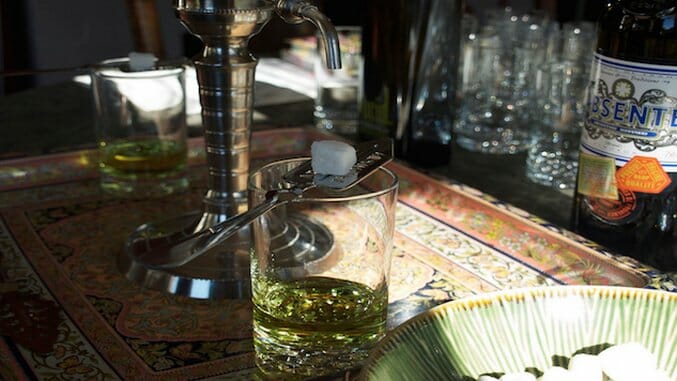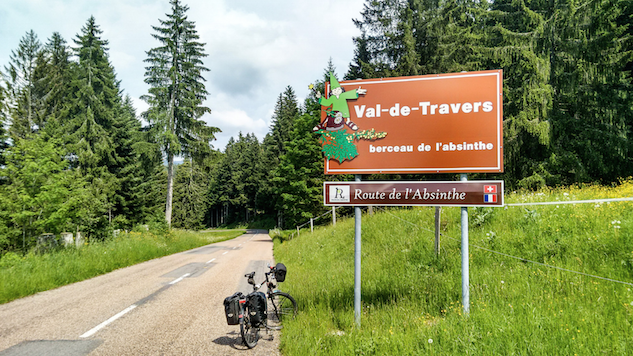From the Source: Swiss Absinthe
Photos: Michael Korcuska/Flickr and Andreas Thut/Flickr Travel Features switzerland
The Green Fairy was friend to many including Pablo Picasso, Vincent Van Gogh and Ernest Hemingway. However, the origins of the great muse are somewhat surprising. Drawing its power from four simple ingredients, the concoction was first made in Switzerland during the late 18th century.
Pierre Ordinaire, a doctor living in Couvet, Switzerland, manufactured and sold the spirit
as a medical elixir. After passing the recipe down to the Henrod sisters, it was sold to Major
Dubied just five years later. Major Dubied then opened the first distillery known as Dubied Père et Fils in Couvet. The second distillery built appeared just across the border in
Pontarlier, France in 1805. Pontarlier’s brand, Maison Pernod Fils, would become one of the most popular and is commonly found in Hemingway’s novels.
Until the green liquor was banned in 1914, absinthe was wildly popular. After the 1990s
revival, the modern understanding of absinthe is closer to a distilled spirit with fennel and green anise. Take a trip with us down the absinthe trail for a closer look at the emerald elixir.

Photo: Ania /Flickr
As the home of absinthe, Switzerland is the only country to form a legal definition of the
liquor which requires distillation rather than cold mixing. The overall process is similar to high-quality gin production.
First distillation produces 72 percent ABV which is reduced and can be bottled clear known as la bleue absinthe. However, most absinthe is green and receives its color from the second step.The maceration of whole herbs such as petite wormwood or hyssop produces the green hue from the plant’s chlorophyll. The natural color process is critical for aging because the chlorophyll remains chemically active. When steeped in distillate, the absinthe gains herbal complexity. Such absinthe is known as absinthe verte.
The drink is prepared and served in a specific fashion. First, an absinthe fountain is filled
with ice water. Next, the absinthe is poured into an absinthe glass and an absinthe spoon is
balanced across the rim. Sugar cubes are most often poised atop the spoon before the glass is placed under a spigot of the fountain. Slowly, the ice water drips overs the sugar cube until it is dissolved and equally dispersed in the now opaque absinthe. Sweetness helps to balance the bitterness of the herbs.
To truly appreciate the Route de L’Absinthe it is important to know how the Green Fairy survived prohibition. During the dry years, la bleue absinthe was carefully obscured in a crevice under tree roots near the Pouetta-Raisse gorges. Only initiated members to the Fontaine à Louis knew to find the liquor which would then be clouded by the icy spring. Since re-legalization in 2005 a small box was installed containing a bottle with which visitors can attempt the tradition.

Photo: jbdodane /Flickr
Near the edge of the Robella forest is a hatch containing a bottle of the elixir. This location is
known as fontaine des fees la robella or “the fountain of the fairies.” One last fountain to visit is the amphitheater-like valley formed by glacial erosion known as fontaine froide du crux-du-van.
Located in the Val de Travers district, the fountain can be reached by car or foot. The picturesque farm of Soliat is accessed from Couvet and close to the summit of the rocky cirque. While Môtiers, Couvet and Travers are all part of the Inventory of Swiss Heritage Sites, there are three structures worth stopping to see. Môtiers’ maison des chats, a beautifully-preserved 16th-century building, abuts several absintheries and offers rare absinthe tastings paired with renowned meals and topped with absinthe ice cream. Boveresse séchoir, the absinthe dryer found in the Val-de-Travers town of Boveresse is known for the draft used to dry wormwood by the structure’s way of rocking back and forth in the wind. Lastly, Die Grüne Fee or “The Green Fairy,” located in Solothurn was the first (legal) absinthe bar. Partake in a tasting at the historic stop.

Photo: Ed Schipul /Flickr
If a bottle to take home is on the list, three distilleries stand out: La Vy Perroud Distillery,
La Vraie Absinthe Distillery and La P’tite Persoz Distillery. Operating since 1962, La Vy Perroud offers absinthe made in the fashion of bootleg days with experience. Tours are by appointment as are sales with optional home delivery.
La Vraie Absinthe hosts tours on Saturdays or by appointment, but to purchase be sure to call a day in advance. Tradition is key at this distillery with a recipe passed down through the generations.
Tours given in French and German last just over an hour at La P’tite Persoz with sales at the distillery. The first female distiller of legal absinthe, Gaudentia Persoz, offers four types of small batch elixir by following her family’s purest tradition hailing from underground days.
Choose a type of absinthe before shopping. Remember that blanche or la bleu absinthe is
only distilled once without herbs, creating a clear product. Green absinthe or absinthe verte contains the herbal complexity most similar to the original elixir. Traditional absinthe calls for eau de vie or white grape spirit, which yields 45 to 74 percent ABV. Lesser-grade alcohol from beets, grains or potatoes yields a higher alcohol by volume percentage. Alternatively-made absinthe by cold mixing or the “bohemian” style yields the highest percentage at 89.9 percent ABV. Note that authentic Swiss absinthe must be made by distillation.
Molly Harris is a freelance writer based in Athens, Georgia.